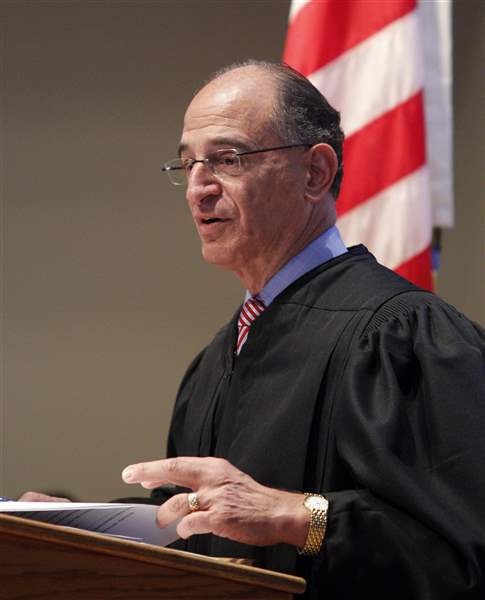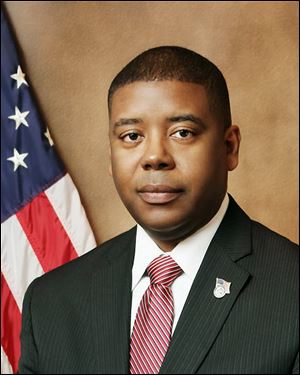
Re-entry court aims to assist ex-cons
Locals trying to keep offenders from trouble to host key U.S. official
6/10/2013
Judge Jack Zouhary helped lead the effort to establish the re-entry court in 2009.
The Blade/Andy Morrison
Buy This Image

Judge Jack Zouhary helped lead the effort to establish the re-entry court in 2009.
After Judge Jack Zouhary took the bench at Toledo’s U.S. District Court, he wanted to find a way to help convicts get on paths after prison that would keep them from coming back.

Samuels
In 2009, he and Magistrate Vernelis Armstrong led the effort to create a re-entry court, which brings just-released violent offenders to court for informal monthly meetings with them and other court officials to work on goals that will keep them out of trouble. The program is voluntary, and just 30 defendants have been admitted so far.
It may be a drop in the bucket, but supporters believe it’s having a ripple effect.
“I say if one person decides to hold his temper or hold his tongue, and that saves his job because he didn’t blow up at the boss, if he didn’t strike out at his wife in a domestic situation, not only is that good for that individual, it’s good for that person’s family, it’s good for society,” said Eric Corns, the supervising pretrial services and probation officer at the federal court in Toledo.
The re-entry court will convene today with a special guest in attendance: Charles Samuels, Jr., director of the Federal Bureau of Prisons. Mr. Samuels, whose official biography says he has launched “inmate skills development and re-entry initiatives,” will be in Toledo along with state and local officials for an afternoon conference dubbed “Road Work Ahead: Revisiting the Path to Re-entry.”
Tailored for those who work on prisoner re-entry and offered as continuing education for the legal community, the conference at the Toledo-Lucas County Public Library’s Main Library downtown is free and open to interested members of the public. It runs from 2 to 5 p.m. in the McMaster Center.
“One of the goals is to get all of the people involved in re-entry in one room, to get everyone talking, especially at this time of budget cuts, so that we can avoid duplication and make our dollars go further,” Judge Zouhary said.
Among those involved in re-entry efforts are the Re-entry Coalition of Northwest Ohio, faith-based groups, probation officers, judges, and defense lawyers. Among those set to speak at today’s event are Mr. Samuels; Gary Mohr, director of the Ohio Department of Rehabilitation and Correction; and Timothy Young, director of the Ohio Public Defender’s Office.
Re-entry programs are based on the idea it’s less expensive and more beneficial to help violent offenders live law-abiding lives than to return them to prison after they reoffend.
“These are guys who have spent most of their lives in prison. Getting out is very hard because they’ve been institutionalized for so long,” said Mark Sherman, assistant director of the education division for probation and pretrial programs at the Federal Judicial Center in Washington.
“Many have been in juvenile justice facilities and then state prison and then federal prison,” Mr. Sherman said. “It’s a revolving door. They’ve got to take control of their lives, and it’s really hard.”
Across the country, approximately half the 94 federal district courts have some kind of re-entry program, Mr. Sherman said.
Not mandated, all the programs have been grass-roots efforts, frequently started by judges interested in curbing recidivism, he said. Most have developed within the last five years.
At the re-entry court in the federal courthouse in Toledo, a small group of former inmates meets with judicial officials around a table. There are no robes or titles.
“Part of the thing I think we have to do is break down what they were used to,” Judge Zouhary said. “They were used to coming to a courthouse for something bad. Now they’re coming to a courthouse where we’re offering help. Some at first don’t believe us, and understandably so. It takes a session or two for them to understand this group really does want to help them.”
Mr. Corns said that since 2009, 11 participants have graduated from the program, three have completed the first phase, and four are currently enrolled. He said one was suspended because of a new offense, while three withdrew, and eight were terminated unsuccessfully.
Judge Zouhary conceded that going through the re-entry court is harder than simply going it alone after prison, but he thinks it’s worthwhile for those willing to make the commitment.
“We have some tough talk,” Judge Zouhary said. “It’s not all Kumbaya.”
Contact Jennifer Feehan at jfeehan@theblade.com or 419-213-2134.